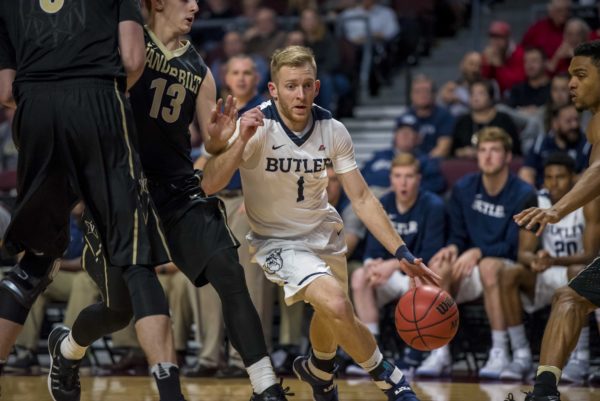Tyler Lewis is Hitting His Stride in Running Butler’s Offense
Posted by Mike Knapp on December 1st, 2016It is hard to tell from just looking at the 5’11”, 157-pound senior, but once upon a time Butler point guard Tyler Lewis was a McDonald’s All-American. Despite limited size, his creativity as a passer and fearlessness in attacking the basket caught the attention of multiple high-major schools, including his ultimate destination, North Carolina State. With playing time fluctuating over two seasons in Raleigh, Lewis decided to transfer to Butler, where a promising start to his junior season gave way to decreased importance after the new year. Lewis entered his final season in college basketball as the only significant holdover in Butler’s backcourt. He has not disappointed.
The Bulldogs are off to an impressive 7-0 start this season and their senior facilitator is a major reason why. The veteran floor general is only averaging a pedestrian eight points per game, but he has been one of the more efficient guards in college basketball through the first couple weeks of the season. Lewis’ offensive rating of 133.3 is the second highest on the Butler roster and is good enough for 83rd nationally. He is also shooting a blistering 77.3 percent from two-point range (24th), and is 5-of-11 on three-point attempts so far this season. Furthermore, his effective field goal percentage of 74.2 percent ranks among the top 20 in the sport.
Lewis’ ridiculous shooting numbers have been a pleasant surprise, but his real value lies in his elite distribution of the basketball. He is currently averaging 8.7 assists per 40 minutes, far and away the best mark on the team, and he also boasts a 38.3 percent assist rate — which puts him among the top 30 nationally. The Bulldogs have showcased one of the most efficient offenses in the nation so far (20th) and it has been humming with Lewis on the floor. Per Hoop Lens, the Bulldogs are scoring a robust 1.26 points per possession when he is on the floor compared with less than 1.00 point per possession when he is on the bench. It’s not hard to see why the offense fails when he’s out — Butler has no other true point guard and its fluid, motion-based sets really stagnate when he’s unavailable — as exhibited by a more than 14 percent drop in field goal percentage (63.6 percent compared with 49.4 percent).
As impressive as he has been on the offensive end of the floor this season, Butler’s defense (which allows only 60.7 points per game) suffers when he is in the lineup (the Bulldogs give up 0.94 points per possession with Lewis in the game compared with 0.83 PPP when he is out). This statistic is not surprising — Lewis lacks both quickness and size to stay with most collegiate guards — but it is also not a significant enough drop to warrant playing him fewer minutes. Lewis’ defense has limited his playing time before, but given his production this season, it will be impossible to keep him off the floor regardless of his defensive contributions. In leading one of the hottest offenses in college basketball, Butler’s fortunes this season may run through its often overlooked point guard.










































